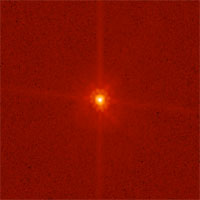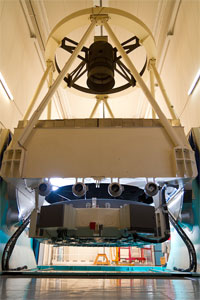
The exploration of primitive bodies beyond the orbit of Neptune, in the Kuiper belt, continues. The hunt continues for remote dwarf planets, the remains of the formation of the solar system … During the night of April 23rd 2011, thanks to a favourable but rare celestial conjunction which had been foreseen numerically by specialists, Makemake (pronounced « Makémaké ») passed in front of a faint star in the constellation of Coma Berenices. The event was tracked by16 telescopes, carefully chosen in the 4 countries of Latin America (Brazil, Uruguy, Argentina, Chile). Seven of them recorded the one minute extinction of the background star. For the first time, this type of phenomenon was observed using large telescopes - the Very Large Telescope VLT (at Paranal) and the New Technology Telescope NTT (at La Silla) of the European Southern Observatory in Chile. The results have appeared in the Thursday November 22nd 2012 issue of the journal Nature.
The stellar occultation
This will be the fourth paper in six years published in Nature on the same subject by the French team of scientists from the Paris Observatory and the CNRS. This team, led by Bruno Sicardy, professor at the Pierre et Marie Curie University and member of the Institut Universitaire de France, has considerable expertise in the observation of stellar occultations by bodies in the Solar System. Already in 2002, this team had obtained unique data on the atmosphere of Pluto. In 2005, the same team had measured the size and density of its satellite Chiron. And in 2010, they showed that Eris is smaller than was believed at the time.
(136472) Makemake is the third largest dwarf planet, after Eris and Pluto. It is at present 7.8 billion km from the Sun (52 astronomical units or au, where 1 au = Sun-Earth distance), i.e. between the distance of Pluto (31 au) et Eris (97 au). By its size and surface composition, Makemake was among the bodies believed to have kept a nitrogen or methane atmosphere.
The estimates will have to be done again, since one of the major by-products of this work is that Makemake does not have a global atmosphere comparable to that of Pluto. The upper limit obtained by this international campaign for the residual pressure of the molecules on the surface of the body does not exceed one hundred-millionth (10-8) of the terrestrial value, or one thousandth of that on Pluto. Astronomers can use this information to constrain the limiting conditions that a dwarf planet must satisfy to create and keep an atmosphere.

Moreover, the measurements lead to an exact value for the size of Makemake. They indicate that the body is slightly elongated, 1430 x 1502 km along two axes. The estimated mean reflectivity (albedo, or brightness in solar light) turns out to be 77 %. This means that Makemake reflects more solar light than Pluto (52 %) but less than Eris (96 %). Be that as it may, Makemake is almost as reflective as fresh snow (albedo 80 %). This pioneering work, pursued for over a decade by the Paris Observatory team, has cleared the way to the detection of other stellar occultations by various transneptunian objects. In the months to come, the most promising targets are Quaoar and Sedna, which might have an atmosphere, as well as Varuna, a large elongated and rapidly rotating body.
This fascinating work will require the use of the giant ground based telescopes and of NASA’s airborne observatory ( Stratospheric Observatory for Infrared Astronomy – SOFIA).
Multimédia
– The stellar occultation by Makemake
A realistic simulation of a stellar occultation by the dwarf planet Makemake. These are archive images from the Digitized Sky Survey rather than recent observations. However, the light curves were recorded by the 3.5m New Technology Telescope NTT at La Silla (Chile).
(ESO / IAA / CSIC / Observatoire de Paris)
– The path of the shadow
Loading player...
An animation showing the path of Makemake’s shadow as it traversed various South American countries.
(ESO/L. Calçada / Observatoire de Paris / LESIA / B. Sicardy)
The eleven observation sites

Collaborations
This campaitn was initiated by a Spanish team at the Grenada Astrophysics Institute, led by Jose Luis Ortiz, in close collaboration with nine scientists from the Paris Observatory, the CNRS, the Pierre et Marie Curie University and the Institut Universitaire de France : Bruno Sicardy, Felipe Braga-Ribas, Emmanuel Lellouch, Jean Lecacheux, Françoise Roques, Pablo Santos Sanz and Thomas Widemann of the Laboratoire d’Études Spatiales et d’Instrumentation en Astrophysique LESIA1 as well as François Colas and Daniel Hestroffer from the Institut de Mécanique Céleste et de Calcul des Éphémérides - IMCCE2.
Teams from Rio de Janeiro (National Observatories and Valongo), from Geneva Observatory, from the Institute of Astrophysics at Liège University, from the University of Sheffield, from the European Southern Observatory, from the SPACE Observatory at San Pedro d’Atacama also participated in this campaign, as weil as many other scientists in Chile, Argentina, Uruguy, Brazil, Spain and Germany.
Référence
No global Pluto-like atmosphere on dwarf planet Makemake from a stellar
occultation, paper to appear in the 22nd November 2012 issue of the journal Nature.
Notes
Past observations made by the same team, published in Nature :
Pluton en 2002
Charon en 2005
Éris en 2010
1 Le Laboratoire d’Etudes Spatiales et d’Instrumentation en Astrophysique LESIA is a departement of the Paris Observatory. It is associated with the CNRS, with Pierre et Marie Curie University, and with the Paris Diderot University.
2L’Institut de Mécanique Céleste et de Calcul des Éphémérides IMCCE is a departement of the Paris Observatory. It is associated with the CNRS, with Pierre et Marie Curie University,, and with Lille University 1 Sciences et Technologies.
To know more
You can find this article on the site of the l’Université Pierre et Marie Curie
See the ESO press release in english
Voir le communiqué ESO en français
Contact sientists – Observatoire de Paris
– Bruno Sicardy
University Professor
01 45 07 71 15
06 19 41 26 15
– Emmanuel Lellouch
Astronomer
01 45 07 76 72
Press officer – Observatoire de Paris
– Sabrina Thiéry
Direction de la communication
01 40 51 23 01
